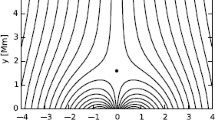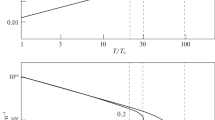Abstract
Observations have shown that the chromosphere networks are rich in features with density higher than the ambient atmosphere. To investigate the effect of horizontal density-inhomogeneity on spicules, here we carry out two-dimensional magnetohydrodynamic (MHD) simulations based on the shock scenario. In a gravitationally stratified solar atmosphere, we insert a vertical preexisting density structure (PeDS) that has higher density than the ambient regions, and then we drive a spicule by a velocity pulse at the bottom of the chromosphere. We find a horizontal flow of 2 km s−1 caused by a rarefaction wave that may have a certain material supplement effect for the spicules and a V-shaped shock front in the chromosphere. An interesting feature found in our experiment is that the existence of PeDS leads to the formation of multiple threads in spicules. Their formation results from the larger density, lower transition region, and higher speeds of magnetoacoustic waves in the PeDS than at its outer boundaries. Parameter studies show that multiple threads of a spicule can be more pronounced in cases with wider velocity pulses and a larger internal/external density ratio in the PeDS. Our study shows that the horizontal density-inhomogeneity in the solar atmosphere is an important factor that is responsible for the complexity of a spicule.








Similar content being viewed by others
References
Beckers, J.M.: 1968, Solar spicules (invited review paper). Solar Phys. 3, 367. DOI. ADS.
Beckers, J.M.: 1972, Solar spicules. Annu. Rev. Astron. Astrophys. 10, 73. DOI. ADS.
Cheng, Q.-Q.: 1992, Fluid motions in the solar atmosphere. I – On the origin and decay of spicules. II – A spicule model with emission lines. Astron. Astrophys. 266, 537. ADS.
Dara, H.C., Koutchmy, S., Suematsu, Y.: 1998, Properties of H\(\alpha \) spicules from disk and limb high-resolution observations. In: Guyenne, T.-D. (ed.) Solar Jets and Coronal Plumes, ESA Special Publication 421, 255. ADS.
De Pontieu, B., McIntosh, S.W., Carlsson, M., Hansteen, V.H., Tarbell, T.D., Boerner, P., Martinez-Sykora, J., Schrijver, C.J., Title, A.M.: 2011, The origins of hot plasma in the solar corona. Science 331, 55. DOI. ADS.
González-Avilés, J.J., Murawski, K., Zaqarashvili, T.V.: 2022, Numerical simulations of a two-fluid jet at a magnetic null point in a solar arcade. Mon. Not. Roy. Astron. Soc. 515, 5094. DOI. ADS.
González-Avilés, J.J., Murawski, K., Srivastava, A.K., Zaqarashvili, T.V., González-Esparza, J.A.: 2021, Numerical simulations of macrospicule jets under energy imbalance conditions in the solar atmosphere. Mon. Not. Roy. Astron. Soc. 505, 50. DOI. ADS.
Hansteen, V.H., De Pontieu, B., Rouppe van der Voort, L., van Noort, M., Carlsson, M.: 2006, Dynamic fibrils are driven by magnetoacoustic shocks. Astrophys. J. Lett. 647, L73. DOI. ADS.
Heggland, L., De Pontieu, B., Hansteen, V.H.: 2007, Numerical simulations of shock wave-driven chromospheric jets. Astrophys. J. 666, 1277. DOI. ADS.
Hollweg, J.V.: 1982, On the origin of solar spicules. Astrophys. J. 257, 345. DOI. ADS.
Jiao, F., Xia, L., Li, B., Huang, Z., Li, X., Chandrashekhar, K., Mou, C., Fu, H.: 2015, Sources of quasi-periodic propagating disturbances above a solar polar coronal hole. Astrophys. J. Lett. 809, L17. DOI. ADS.
Konkol, P., Murawski, K., Zaqarashvili, T.V.: 2012, Numerical simulations of magnetoacoustic oscillations in a gravitationally stratified solar corona. Astron. Astrophys. 537, A96. DOI. ADS.
Kuźma, B., Murawski, K., Kayshap, P., Wójcik, D., Srivastava, A.K., Dwivedi, B.N.: 2017b, Two-fluid numerical simulations of solar spicules. Astrophys. J. 849, 78. DOI. ADS.
Kuźma, B., Murawski, K., Zaqarashvili, T.V., Konkol, P., Mignone, A.: 2017a, Numerical simulations of solar spicules: adiabatic and non-adiabatic studies. Astron. Astrophys. 597, A133. DOI. ADS.
Li, X., Zhang, J., Yang, S., Hou, Y., Erdélyi, R.: 2018, Observing Kelvin-Helmholtz instability in solar blowout jet. Sci. Rep. 8, 8136. DOI. ADS.
Martínez-Sykora, J., De Pontieu, B., Hansteen, V.H., Rouppe van der Voort, L., Carlsson, M., Pereira, T.M.D.: 2017, On the generation of solar spicules and Alfvénic waves. Science 356, 1269. DOI. ADS.
Mignone, A., Bodo, G., Massaglia, S., Matsakos, T., Tesileanu, O., Zanni, C., Ferrari, A.: 2007, PLUTO: a numerical code for computational astrophysics. Astrophys. J. Suppl. 170, 228. DOI. ADS.
Murawski, K., Zaqarashvili, T.V.: 2010, Numerical simulations of spicule formation in the solar atmosphere. Astron. Astrophys. 519, A8. DOI. ADS.
Panesar, N.K., Sterling, A.C., Moore, R.L., Tiwari, S.K., De Pontieu, B., Norton, A.A.: 2018, IRIS and SDO observations of solar jetlets resulting from network-edge flux cancelation. Astrophys. J. Lett. 868, L27. DOI. ADS.
Pasachoff, J.M., Jacobson, W.A., Sterling, A.C.: 2009, Limb spicules from the ground and from space. Solar Phys. 260, 59. DOI. ADS.
Poletto, G.: 2015, Solar coronal plumes. Living Rev. Solar Phys. 12, 7. DOI. ADS.
Qi, Y., Huang, Z., Xia, L., Li, B., Fu, H., Liu, W., Sun, M., Hou, Z.: 2019, On the relation between transition region network jets and coronal plumes. Solar Phys. 294, 92. DOI. ADS.
Qi, Y., Huang, Z., Xia, L., Fu, H., Guo, M., Hou, Z., Liu, W., Sun, M., Liu, D.: 2022, Statistical properties of H\(\alpha \) jets in the polar coronal hole and their implications in coronal activities. Astron. Astrophys. 657, A118. DOI. ADS.
Raouafi, N.-E., Stenborg, G.: 2014, Role of transients in the sustainability of solar coronal plumes. Astrophys. J. 787, 118. DOI. ADS.
Roberts, B.: 1979, Spicules: the resonant response to granular buffeting? Solar Phys. 61, 23. DOI. ADS.
Skogsrud, H., Rouppe van der Voort, L., De Pontieu, B.: 2014, On the multi-threaded nature of solar spicules. Astrophys. J. Lett. 795, L23. DOI. ADS.
Smirnova, V., Konkol, P.M., Solov’ev, A.A., Murawski, K.: 2016, Numerical simulations of solar spicule jets at a magnetic null-point. Solar Phys. 291, 3207. DOI. ADS.
Sterling, A.C.: 2000, Solar spicules: a review of recent models and targets for future observations – (invited review). Solar Phys. 196, 79. DOI. ADS.
Sterling, A.C., Mariska, J.T.: 1990, Numerical simulations of the rebound shock model for solar spicules. Astrophys. J. 349, 647. DOI. ADS.
Suematsu, Y., Ichimoto, K., Katsukawa, Y., Shimizu, T., Okamoto, T., Tsuneta, S., Tarbell, T., Shine, R.A.: 2008, High resolution observations of spicules with Hinode/SOT. In: Matthews, S.A., Davis, J.M., Harra, L.K. (eds.) First Results from Hinode, Astronomical Society of the Pacific Conference Series 397, 27. ADS.
Tanaka, K.: 1974, Evolution of chromospheric fine structures on the disk. In: Athay, R.G. (ed.) Chromospheric Fine Structure 56, 239. ADS.
Tsiropoula, G., Alissandrakis, C.E., Schmieder, B.: 1994, Time evolution of fine structures in the solar chromosphere. Astron. Astrophys. 290, 285. ADS.
Tziotziou, K., Tsiropoula, G., Mein, P.: 2003, On the nature of the chromospheric fine structure. I. Dynamics of dark mottles and grains. Astron. Astrophys. 402, 361. DOI. ADS.
Tziotziou, K., Tsiropoula, G., Mein, P.: 2004, On the nature of the chromospheric fine structure. II. Intensity and velocity oscillations of dark mottles and grains. Astron. Astrophys. 423, 1133. DOI. ADS.
Wedemeyer-Böhm, S., Lagg, A., Nordlund, Å.: 2009, Coupling from the photosphere to the chromosphere and the corona. Space Sci. Rev. 144, 317. DOI. ADS.
Wei, H., Huang, Z., Long, D.M., Fu, H., Xia, L., Xiong, M., Li, B.: 2023, Concurrence of a Kelvin-Helmholtz instability and Kármán vortex street in the Sun’s corona. Astron. Astrophys. 678, L7. DOI. ADS.
Zaqarashvili, T.V., Erdélyi, R.: 2009, Oscillations and waves in solar spicules. Space Sci. Rev. 149, 355. DOI. ADS.
Acknowledgments
We thank the anonymous reviewer for the constructive and helpful suggestions and comments. PLUTO is developed at the Dipartimento di Fisica, Torino University in a joint collaboration with INAF, Osservatorio Astronomico di Torino and the SCAI Department of CINECA.
Funding
This research is supported by the National Natural Science Foundation of China (42174201, 42230203) and the National Key R&D Program of China No. 2021YFA0718600.
Author information
Authors and Affiliations
Contributions
C.Z. and Z.H. wrote the manuscript; C.Z. carried out the simulations under the supervisions of B.L., Z.H., M.S. and M.G.; Y.Q. and L.X. contributed to initiation of the project; all the authors had discussion on the work and reviewed and commented the manuscript.
Corresponding author
Ethics declarations
Competing interests
The authors declare no competing interests.
Additional information
Publisher’s Note
Springer Nature remains neutral with regard to jurisdictional claims in published maps and institutional affiliations.
Supplementary Information
Below is the link to the electronic supplementary material.
Rights and permissions
Springer Nature or its licensor (e.g. a society or other partner) holds exclusive rights to this article under a publishing agreement with the author(s) or other rightsholder(s); author self-archiving of the accepted manuscript version of this article is solely governed by the terms of such publishing agreement and applicable law.
About this article
Cite this article
Zhang, C., Huang, Z., Li, B. et al. The Effect of Horizontal Density-Inhomogeneity on Spicules Driven by Vertical Velocity Pulses. Sol Phys 299, 53 (2024). https://doi.org/10.1007/s11207-024-02301-2
Received:
Accepted:
Published:
DOI: https://doi.org/10.1007/s11207-024-02301-2




